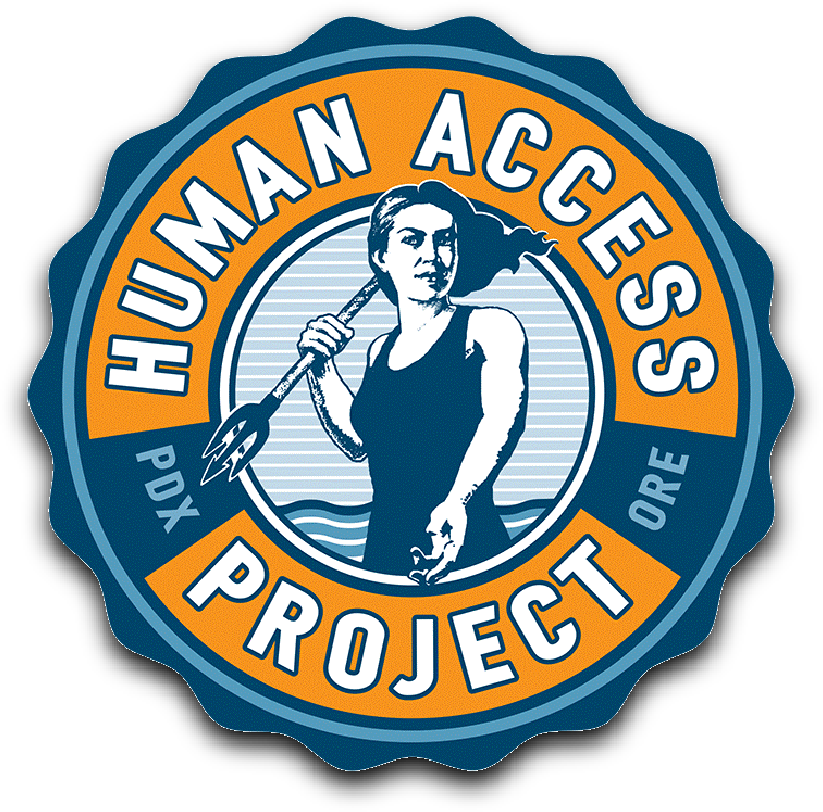Ross Island Lagoon HAB

SOLVING THE ROSS ISLAND LAGOON HARMFUL ALGAE BLOOM
Ross Island Lagoon is a man-made pond inside of the Willamette River. Today, it suffers from recurring hazardous algal blooms (HABS) also known as harmful cyanobacteria blooms (HCBs). These blooms degrade water quality, threatening the health of our river, wildlife, pets and swimmers.
Alongside a coalition of diverse, interested parties, the Human Access Project (HAP) is leading a science-based effort to mitigate the HCB by restoring river flow through the lagoon.
Why Ross Island Has a HCB Problem
Ross Island was once two separate islands. In 1926 the US Army Corps of Engineers constructed an embankment connecting the two islands and cutting off the natural downstream flow of the river. Ross Island Sand and Gravel company proceeded to excavate the newly merged island for gravel, creating a massive (140 acre) stagnant pool with depths as great as 120’. As a result:
-
Water in the lagoon barely moves, creating warm, stagnant conditions.
-
These conditions allow cyanobacteria to flourish each summer.
-
Blooms can spread downstream, affecting wildlife and river recreation far beyond the lagoon.
Climate change — drier springs, hotter summers, and unpredictable snowpack — is accelerating the problem, making HCBs more frequent, more intense, and longer lasting.
Why It Matters
Public Health
Cyanobacteria can produce toxins that pose serious risks to people and pets. During blooms, public health advisories warn swimmers, boaters, and dog owners to avoid contact with the water.
Ecological Impacts
HCBs harm the river’s ecological integrity by:
-
Reducing oxygen levels
-
Threatening invertebrates and fish
-
Eliminating cold, shallow, food-abundant rearing habitat relied upon by threatened juvenile salmon
As one of the last remaining wild spaces along the Lower Willamette River, Ross Island has the potential to provide essential habitat to threatened fish and wildlife. But the increasing presence of HCBs is transforming it into an ecological hazard.
River Access & Equity
The Willamette River is Portland’s second largest public space and natural area. When HCBs spread downstream, they limit safe river access for thousands of Portlanders who rely on the Willamette for cooling, recreation, and connection to nature. In the hottest months of the summer, this disproportionately affects communities with limited or no access to air conditioning or other swimming spaces. The Ross Island HCB also threatens the health of salmon, a first food for many of the Indigenous peoples who call the Lower Willamette home.
We have a responsibility to resolve this man-made problem which disproportionately impacts frontline Portland communities.
A Fix Exists: Restore Flow Through a Flushing Channel
The good news: this problem is solvable.
Since 2017, HAP has partnered with Oregon State University to study the lagoon and model long-term solutions. Our research indicates that restoring natural circulation is the single most effective way to suppress HCBs.
The Flushing Channel Solution
A proposed flushing channel at the upstream end of the lagoon would:
-
Reintroduce steady river flow
-
Cool the water
-
Introduce mixing which favors beneficial algae growth relied upon by juvenile salmon
-
Restore salmon habitat
-
Dramatically reduce HCB formation, improving overall water quality and enhancing safe recreational access downstream
This is a practical, science-driven solution that repairs a human-made problem.
Collaboration Is Key
Ross Island is privately owned, meaning progress requires cooperation between HAP, property owners, government agencies, scientists, and community advocates. HAP is actively building this coalition.
Why Action Is Urgent
If nothing changes, Ross Island Lagoon will continue producing harmful cyanobacteria blooms. With climate change warming the river, HCBs will become a regular summer reality — jeopardizing water quality, wildlife habitat, and Portland’s emerging river culture.
Fixing Ross Island Lagoon now ensures the long-term health of the Lower Willamette River and the wildlife and humans that depend on it.
How You Can Help
Support the Solution
Your contribution helps fund scientific modeling, engineering design, and the advocacy needed to move this project forward.
Advocate
Community voices matter. Show your support for restoring flow to Ross Island Lagoon by engaging with local leaders and agencies.
Stay Connected
Sign up for updates to follow progress, share information, and learn when public engagement opportunities arise.
Together, We Can Restore Ross Island Lagoon
This lagoon has the potential to become a thriving ecological refuge and a healthy part of a swimmable Willamette River. With the right action, Ross Island can shift from a source of harmful algae to a symbol of restoration; a place where wildlife and people can thrive.




